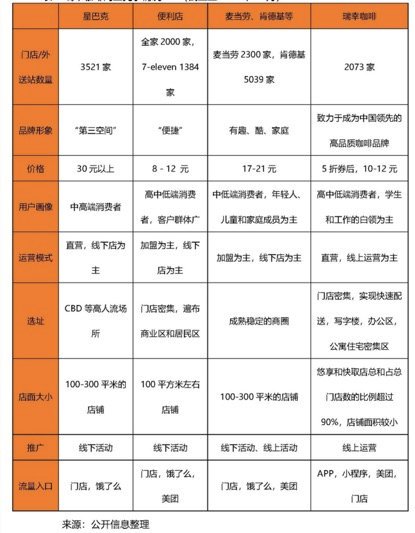Starbucks, which creates the third offline space, also has a dream of the Internet.

Professional coffee knowledge exchange more coffee bean information please follow the coffee workshop (Wechat official account cafe_style)
At Starbucks, which is nearly 50 years old, the "midlife crisis" is also approaching quietly.
In the 20 years since its entry into the Chinese market, Starbucks has brought its "third space" to China, peddling culture other than coffee, and the Asia-Pacific market has become its important core engine, sitting firmly on Diaoyutai in the Chinese coffee industry. However, according to the latest earnings data, revenue growth in the pan-American region, which Starbucks mainly relies on, has slowed significantly, while in the Asia-Pacific region, which is dominated by China, the growth rate is even 0% month-on-month. Starbucks is facing the challenge of "fourth Space", which is based on mobile networking.
Among them, Luckin Coffee, less than three years old, disrupted the situation with the "Internet" as the spear, and new tea brands such as Nai Xue's tea and Lele tea poured out one after another to cut the market.
Starbucks has an Internet dream to tide over the midlife crisis.
Time and space
Some people say that there are two kinds of religions in Milan, one is fetishism, the other is Catholicism.
What Starbucks founder Schultz found here is the former, a key to the coffee business.
One spring in 1983, Schultz set foot on the land of Milan, Italy. Milan, as the center of Italian commerce, industry and even fashion industry, not only has the shabby appearance of the bright sun-shining square and balcony porch, but also has full cultural taste, and the life of Milan people is wanton and rich.
Milan is a city with heavy use of coffee, where coffee culture prevails.
At that time, Milan had a population of 1.3 million, more than 1500 coffee bars, and an Italian coffee bar could be seen almost every 20 yards. It is no less dense than convenience stores in Japan, while Seattle, where Schultz is located, has just over 650 coffee stores.
Milan awakens the day from coffee, and almost every cafe in the morning is packed with people, holding a cup of espresso and watching the Italian opera in the store to get rid of the drowsiness in the morning. In the afternoon, people come in one after another to chat with the coffee maker in the mellow aroma of coffee and spend a pleasant afternoon at leisure. The twilight is sinking, and many coffee bars even put their seats on the side of the road, where people stop to chat and relieve the tiredness or boredom of the day's work as well as aperitif and pastries.
Obviously, in the world of Milan, coffee split another space.
Schultz was full of emotion. What excites him is not that the coffee around the tip of the tongue is mellow, but that the coffee maker is adept at preparing every serving of coffee every 15 seconds, from crushing coffee beans to tamping coffee, putting coffee in a filter bowl, putting coffee out, loading a plate, and so on. It is a socially centered way of selling coffee.
With coffee as the carrier, the cafe creates a "third space" different from the work scene or home scene, where users can go to Starbucks to chat, read, study, work or even be in a daze. Starbucks is determined to create a new style and taste to infect customers.
In Starbucks, each color is specially designed, surrounded by warm lights, comfortable sofas or wooden seats, Western abstract art and exquisite European ornaments. European classics or violin solos are played in the ear, and a dazzling array of coffee beans are displayed on the bar.
All the meticulous design and arrangement is nothing more than giving users a unique experience, stopping here, and then naturally arriving at the transaction.
Before that, it was widely believed that running coffee drinks was the same as running cheese hotpot and fashionable new things, making a profit at a break even. This is still a "simple" way of retailing. After that, however, Starbucks will not focus on coffee as the core, but will focus on coffee-building a third space and peddling culture.

Starbucks' intention is clear: to create a place where people can take a nap after the hustle and bustle of work, a small oasis in a noisy city.
Using space to replace users' time, the longer people stay, the better it is for Starbucks.
With the pace of store expansion, Starbucks chain stores are also gradually pushed to the world.
At the beginning of Schultz's acquisition of Starbucks in 1987, the company had only 11 stores. In less than three years, the number of stores reached 85, almost eightfold. Today, Starbucks has more than 30, 000 stores worldwide. It is a $90 billion listed company.
There is no doubt that the store is Starbucks "grab" the tentacles of users, where it goes is business. In the words of Starbucks COO, the key words in the third space are comfort, connectivity, and socializing.
From space to user time, Starbucks has created its own business legend. however, with the increasing maturity and penetration of the mobile Internet, Starbucks has also reached an inflection point in its development.
For the full year of fiscal 2018, Starbucks' net income reached a record $24.7 billion, up 10 per cent from a year earlier, according to the latest earnings figures. But its same-store sales in china grew by only 1%, a rebound from the third quarter. In the domestic coffee market, there are a lot of comments about Starbucks entering the "midlife crisis", and the corporate crisis is particularly intractable in the Chinese market.
Last month, the largest shareholder meeting in Starbucks history decided to rethink the third-party culture of the chain. There is no doubt that the Internet movement of retail has come, and a competition of "time for space" is coming as expected.
In the era of mobile Internet, the time of users has been transferred to online. Due to the limitations of physics, time and other conditions, the number of users that Starbucks can reach is also reduced accordingly. At this time, the gathering place of traffic is not the bustling mini-bars of London, the cozy coffee bars on the streets of Paris, the dignified and elegant teahouses in Beijing, the coffee space of Starbucks and other third-party spaces, but the "fourth space" with the network as the carrier.
In other words, the convenient and fast experience that the Internet can achieve is in parallel with the "third space" of the offline scene, and the way of exchanging stores for the flow of people has changed, and it is necessary to exchange the efficiency and experience of the network for development.
At a recent shareholder meeting, Starbucks spokesman Johnson announced "Starbucks' first" bold investment, which will invest $100m in Valor Siren Ventures, a new venture fund led by private equity firm Valor equity Partners, to focus on "new retail" innovation. "innovative ideas are the fuel of the future," he said.
In fact, middle-aged Starbucks has always had an Internet dream.
As early as 2008, Starbucks took the lead in setting up CDO (Chief Digital Officer) to jump into Starbucks' digital transformation. However, up to now, Starbucks still has not delivered a satisfactory answer paper.
Apprentice and catfish
Competition is to have the spirit of running water, where there is an opportunity, where it flows.
Since last year, the coffee industry has killed a spoiler with "Mingdong temperament"-Luckin Coffee. Although Tang Wei and Zhang Zhen's "who doesn't love this cup" is considered a bit noisy, it doesn't stop Luckin Coffee from pointing to Starbucks, the god of coffee that has been seated in China for 20 years.
Luckin Coffee founder and CEO Qian Zhiya entered the game with 1 billion yuan and threatened to bring Internet competition to the coffee industry. Starbucks will soon feel it. Whether it is marketing or true temperament, it is obvious that Luckin Coffee is not playing tricks.
In less than two years of attack, Luckin Coffee produced his own report card.
In terms of capital, Luckin Coffee raised a total of US $400m in two rounds of financing last year, accounting for 87 per cent of the total financing of China's coffee industry in the past five years, with a valuation of more than US $2 billion, setting a new high for the coffee industry. in addition, Luckin Coffee is already on the road to IPO and hopes to list in the US in May or June this year, with a valuation of US $3 billion.
In addition, in terms of speed, Ruixing announced in January this year that Luckin Coffee had laid out 2073 stores in 2018, 2500 new stores will be opened in 2019, and the total number of Luckin Coffee stores will exceed 4500 by the end of the year, surpassing Starbucks in terms of the number of stores and the number of cups sold.
In fact, regardless of capital or speed, Luckin Coffee is worthy of the catfish of the coffee industry. From the dimension of the Internet, Starbucks can only be regarded as an apprentice.
Luckin Coffee is an out-and-out Internet believer.

Photo source: iResearch data on competition among Starbucks, Luckin Coffee and other retailers (data as of December 2018)
Rui Xing was born with the golden spoon of the Internet, and his team's genes came from ride-hailing family Shenzhou Youche. In the style of play, Ruixing is also very Internet, it basically follows the flow of ideas. Luckin Coffee CMO Yang Fei once went straight to the topic, saying that the whole Internet marketing is "eager for quick success and quick profit", "urgent success" is to quickly establish a brand, and "near profit" is to quickly get users. This is the "flow pool" idea put forward by Yang Fei.
Therefore, "burning money for the market" is the first killer mace for Luckin Coffee's expansion and growth. But the more important thing is that Luckin Coffee's digitalization in the chain from production to marketing is not simply at the marketing level, it tries a way to improve retail efficiency through digital transformation.
In the uniform direct operation, Ruixing regards the store as the connector of traffic, so Lucky's "only fast and unbroken" pace of opening a store, while digitization is really reflected in the back end. For example, the order data is automatically generated by the system every day, the operation of each coffee machine can be detected in the background, and the cashier is done online. Luckin Coffee wants to create from dispatch, order, quality control to transactions, user data management and so on to achieve intelligence, to achieve thousands of people on the APP.
Compared with Starbucks, Rui Xing "sacrifices" the routine of space, directly regards the store as the entrance of traffic, and serves everything for traffic. It is a pure online game, and it can be said to be a practical practitioner of the Internet of coffee retail.
However, Lucky also has Lucky's problems, such as the core of retail-- how to polish the quality of products, which is the red line to the essence, for example, the grasp of strategy and rhythm, burning money is easy to play with fire, and a little carelessness is prone to accidents.
The boat is good to turn around, compared with the $90 billion Starbucks, it is not easy to change the rhythm and style of play. On the one hand, it will face many problems and challenges in the transformation of traditional retail genes; on the other hand, it needs to rely on different Internet environments, laws and ways of playing at home and abroad.
However, if it doesn't work, it hurts, and Starbucks' road to exploring the Internet has never stopped.
Imitation and metamorphosis
From the third space to the fourth space, Schultz has his unique strategic sense of smell.
Schultz returned as CEO in 2008 and was keenly aware of changes in consumer behavior. The first thing he did was to embrace the Internet and digitalization.
Starbucks' first CDO is responsible for the entire core digital business of Starbucks, including global digital marketing, websites, mobile terminals, social media, Starbucks Card, customer loyalty programs, e-commerce, Wi-Fi, Starbucks digital networks, and emerging in-store digital and entertainment technologies. Before that, Starbucks' digital marketing, Starbucks card business (Starbucks Card and mobile payments) and customer loyalty program were three independently operated departments, which were later integrated.
"Digitalization is not just a website or a point-of-sale system, but the ability to connect with consumers and subvert their experiences to drive business growth." Just as Starbucks defines digitization. Retail digitization is not only in the level of marketing, but also in the changes of people, goods and scenes.
Behind this is actually the test of data ability.
In the era of getting up early, especially in the era of PC, the digitization of Starbucks is more related to the digitalization of store management, membership management, marketing and other aspects, which really involves the transformation from sales capacity to data capacity, and from retail thinking to users' thinking, which is a long and difficult process.
In fact, in recent years, Ali, JD.com, SUNING and other retail giants have been promoting the digital transformation of retail.
Schultz mentioned the anxiety of new retail in a speech at Tsinghua University: "every brick-and-mortar store is threatened by e-commerce because of Amazon, Alibaba and so on." This means a big adjustment for the retail industry. "
Do as the Romans do. In fact, China's Wechat has been holding hands with Starbucks since 2016 in terms of mobile payment, membership fission, online and offline diversion. However, under the offensive of Ali's new retail, Starbucks turned to Ali to make a further attempt in the scene, members and goods, seeking a breakthrough in the online and offline scene linkage.
There is no doubt that Alibaba covets the offline traffic brought by Starbucks store resources, while Starbucks can enjoy the complementarity of Ali online traffic and the breakthrough in sales brought by minute-level distribution.
Starbucks hand in hand with Ali
In September last year, Starbucks teamed up with ele.me to launch a "dedicated star delivery" delivery business, which was seen by Starbucks as a big breakthrough. In the 90 days of holding hands with Ali, the number of Starbucks active Chinese members has nearly tripled to nearly 7 million, 90 per cent of whom are active users of Starbucks APP.
At the shareholders' meeting on March 20, Starbucks COO and Roz Brewer, president of the United States, pointed out that Starbucks' performance growth depends on solid innovation. He is looking forward to the breakthrough in the performance of the special star. As a result, Starbucks has also copied the "special star delivery" service from China to the world. It first entered Japan in November 2018, and will enter the United Kingdom and the United States again in January this year. So far, it has landed in 12 countries. At the general meeting of Starbucks shareholders on March 20th, Roz Brewer, president of Starbucks USA, said it had been extended to the American version of "special star delivery" in 1600 stores across the United States.
Wang Jingying, CEO of Starbucks China, said that digital payments, social gifts, new retail technology solutions and mobile orders are in the order of priority when analyzing the upgrading of digital business.
It is not difficult to see that Starbucks' path to realize the Internet dream is a gradual way of improvement.
Some analysts have believed that for coffee retail giants like Starbucks, the Internet transformation is obviously more than just online takeout-omni-channel service implementation, more refined membership operations, and more intimate consumer experiences. deeper user interaction and so on.
In fact, not only Starbucks, but also large physical supermarkets from overseas, such as Carrefour, Wal-Mart and Auchan International, are facing more pressure of interconnection transformation in China. Among them, many supermarkets have become unsatisfied, because digital in China has its own set of standards, a set of standards in mobile payment, logistics and user experience.
For example, the breakthrough in minute-level logistics in the field of fast food consumption is actually an "inhumane" approach in the West, because the cost of service in the West is very high. In fact, the reason why minute-level logistics can be realized in China is that it is a new standard jointly realized on the basis of new technology and commercial transformation, which almost takes into account the interests and demands of many parties, and has a strong non-replicability.
Thus it can be seen that Starbucks' Internet dream did not happen overnight.
Important Notice :
前街咖啡 FrontStreet Coffee has moved to new addredd:
FrontStreet Coffee Address: 315,Donghua East Road,GuangZhou
Tel:020 38364473
- Prev

Robots make mistakes, too. Is there a long way to go before fully automated coffee technology matures?
Professional coffee knowledge exchange More coffee bean information Please pay attention to a coffee robot in the Metreon Shopping Center in San Francisco's South Ma District (Weixin Official Accounts cafe_style), which recently appeared "midlife crisis." Customers find it vibrating from time to time, customers order, it sometimes fails to deliver coffee as requested. Located in Metreon Food Court
- Next

Capital is keen to open coffee stores only because of the high cost of access by users?
Professional coffee knowledge exchange more coffee bean information please follow the coffee workshop (Wechat official account cafe_style) new retail coffee is springing up. Recently, fresh e-commerce has launched the Mini Program Little Red Cup online every day to compete with Luckin Coffee at a low price. On the other hand, Luckin Coffee reported the news that the coffee machine was mortgaged to guarantee the debt. Under the pressure of capital, the rapid expansion of coffee shops is
Related
- Why are the coffee in some coffee shops not enough after being frozen? What should I make up for my American latte cappuccino coffee after being frozen?
- How much water does it take to steam coffee by hand? Why is the coffee brewing and steaming time 30 seconds? What is the purpose of steaming coffee?
- The suspected drink contains too much caffeine! Overlord Tea Lady responds urgently!
- Starbucks rejects antique paper coupons?! Netizen: Missed marketing opportunities!
- What ratio of water temperature and ground does the smart cup method use to press coffee? The difference between brewed coffee and filtered coffee?
- What is the standard process for the purpose of coffee cup testing? What is the difference between hand-brewed coffee and cup testing?
- How to use hand-brewed coffee paragon small golden balls? How does cold coffee lock in the aroma of coffee?
- Is American coffee black? What is the difference between American coffee and drip coffee?
- Unexpected! Well-known tea beverage brand Lele Tea will withdraw from the Zhengzhou market!
- Starbucks enters the fashion and beauty industry?! Netizen: Give me an ice American eye cream

